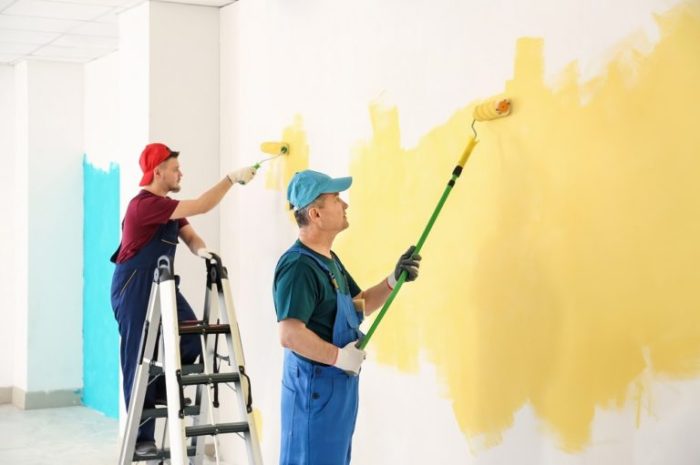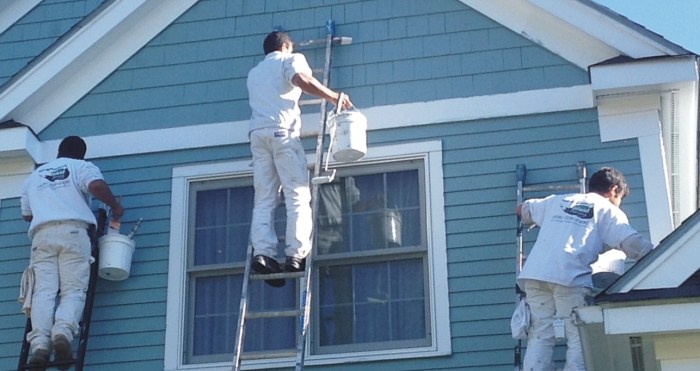Embark on a journey through the world of house painters, exploring their roles, services, techniques, and safety measures. Discover the artistry and skill behind transforming houses into stunning works of art.
Delve into the intricacies of house painting, from the preparation phase to the final brushstroke, and gain insights into this essential aspect of home improvement.
What Do House Painters Do?

House painters are skilled professionals who specialize in painting various surfaces, particularly walls and ceilings, to enhance the appearance of residential properties. Their typical duties include:
- Preparing surfaces by cleaning, sanding, and priming them before painting.
- Applying paint or other finishes using brushes, rollers, or sprayers.
- Ensuring color consistency and matching paint to the desired shade.
- Protecting surrounding areas from paint splatter and ensuring a neat finish.
- Inspecting the work to ensure it meets quality standards and client specifications.
Skills Required for a House Painter
House painters need a combination of technical skills and artistic abilities to excel in their profession. Some essential skills include:
- Attention to detail to ensure precise and clean work.
- Color matching and coordination skills for achieving the desired aesthetic.
- Physical stamina and dexterity to work with various tools and equipment for extended periods.
- Knowledge of different painting techniques and finishes to cater to diverse client preferences.
Tools and Equipment Used by House Painters
House painters rely on a variety of tools and equipment to perform their job efficiently. Some common examples include:
- Paintbrushes and rollers for applying paint to different surfaces.
- Painter's tape to protect trim, edges, and other areas from accidental paint application.
- Drop cloths to cover floors and furniture and prevent paint spills.
- Sandpaper and sanding blocks for preparing surfaces by smoothing out imperfections.
- Spray guns for applying paint quickly and evenly on large surfaces.
Types of House Painting Services
When it comes to house painting, there are various types of services that painters can offer to meet different needs and preferences. Whether it's refreshing the interior walls or giving a new look to the exterior of a house, professional painters have the skills and expertise to transform any space.
Interior Painting
- Interior painting involves painting the walls, ceilings, and other surfaces inside a house. It is a great way to update the look of a room, enhance the decor, and create a fresh and inviting atmosphere.
- Professional interior painters use high-quality paint and tools to ensure a smooth and even finish. They also pay attention to detail, such as proper surface preparation, to achieve long-lasting results.
- Interior painting can include painting individual rooms, accent walls, trim work, cabinets, and more.
Exterior Painting
- Exterior painting focuses on painting the outside of a house, including the walls, siding, trim, doors, and other exterior surfaces. It not only enhances the curb appeal of a home but also provides protection against the elements.
- Professional exterior painters are skilled in working with various types of exterior surfaces and know how to choose the right paint that can withstand harsh weather conditions.
- Exterior painting requires proper surface preparation, such as cleaning, scraping, and priming, to ensure the paint adheres well and lasts longer.
Specialty Painting Services
- Specialty painting services go beyond basic interior and exterior painting and involve techniques that require specialized skills and expertise.
- Examples of specialty painting services include faux finishes, decorative painting, texture painting, mural painting, and more.
- Faux finishes can replicate the look of materials like marble, wood, or fabric, adding a touch of elegance and sophistication to a space.
- Mural painting involves creating custom designs or artwork on walls, ceilings, or other surfaces, turning them into stunning focal points.
Preparation for Painting
When it comes to painting a house, proper preparation is key to achieving a smooth and long-lasting finish. This process involves several important steps that should not be overlooked.
Choosing the Right Paint Colors
Before starting the painting process, it is crucial to choose the right paint colors for your house. Consider factors such as the architectural style of the home, the surrounding environment, and personal preferences. You can also consult with a professional color consultant to help you make the best decision.
Surface Preparation Importance
Surface preparation is a critical step that should not be skipped when painting a house. Properly preparing the surfaces ensures that the paint adheres well and provides a smooth finish
- Clean the surfaces: Start by cleaning the walls, trim, and other surfaces to remove dirt, dust, and grease. This can be done with soap and water or a mild detergent.
- Repair any damage: Inspect the surfaces for any cracks, holes, or imperfections. Fill in these areas with spackling or caulk and sand them smooth once dry.
- Sand the surfaces: Lightly sand the surfaces to create a smooth and uniform texture. This helps the paint adhere better and provides a professional finish.
- Prime the surfaces: Applying a coat of primer before painting can help seal the surface, improve adhesion, and ensure even coverage of the paint.
Techniques and Methods
House painters utilize various techniques and methods to achieve a professional finish when painting a house. Understanding the differences between brush, roller, and spray painting methods is key to successfully completing a painting project.
Brush Painting
Brush painting is a traditional method that offers precision and control when painting smaller areas or detailed surfaces. It is commonly used for trim work, corners, and edges that require careful attention. To achieve a smooth finish with a brush, it is essential to use high-quality brushes and apply multiple thin coats of paint.
Roller Painting
Roller painting is a popular choice for covering large surfaces quickly and efficiently. It is ideal for walls and ceilings, providing a uniform finish with minimal effort. When using a roller, make sure to choose the appropriate nap length for the surface texture and apply paint in a "W" or "M" pattern to avoid streaks or lap marks.
Spray Painting
Spray painting is a fast and efficient method that is commonly used for exterior painting or large surface areas. It can achieve a smooth, even coat of paint in less time compared to traditional methods. However, proper masking and ventilation are crucial when using a sprayer to prevent overspray and ensure a clean work environment.
Tips for Achieving a Professional Finish
- Prepare the surface properly by cleaning, sanding, and priming before painting.
- Use high-quality paint and tools to ensure a durable and long-lasting finish.
- Apply paint in thin, even coats to prevent drips and achieve a smooth texture.
- Work in sections and maintain a wet edge to blend paint seamlessly.
- Allow sufficient drying time between coats to avoid peeling or cracking.
- Inspect the work under different lighting conditions to identify any imperfections and make necessary touch-ups.
Safety Measures

House painters need to prioritize safety while working to ensure a hazard-free environment. This includes following specific precautions, using personal protective equipment, and handling paint and materials safely.
Identify safety precautions
- Always ensure good ventilation in the work area to prevent inhalation of fumes.
- Avoid smoking or open flames near painting materials.
- Keep work areas clean and organized to prevent slips, trips, and falls.
- Use caution when climbing ladders and scaffolding, ensuring they are secure and stable.
Importance of using personal protective equipment
- Wear goggles, gloves, masks, and appropriate clothing to protect eyes, skin, and respiratory system from exposure to paint and chemicals.
- Protective gear helps minimize the risk of injuries and health issues associated with painting tasks.
Handling and disposing of paint and materials
- Store paints in a cool, dry place away from children and pets.
- Dispose of paint and painting materials according to local regulations to prevent environmental contamination.
- Avoid pouring excess paint down drains or into the soil; use designated disposal sites.
Conclusion
As we conclude our exploration of house painters, we reflect on the dedication and expertise required to bring color and life to homes. From choosing paint colors to mastering painting techniques, house painters play a crucial role in creating beautiful living spaces.
FAQ Section
What are the typical duties of house painters?
House painters are responsible for preparing surfaces, applying paint, and ensuring a high-quality finish.
What types of house painting services are available?
House painters offer services for interior painting, exterior painting, specialty finishes, and more.
How do you choose the right paint colors for a house?
Consider factors like natural light, room size, and desired atmosphere when selecting paint colors.
What safety precautions should house painters follow?
House painters should wear protective gear, work in well-ventilated areas, and follow proper disposal practices for paint materials.









